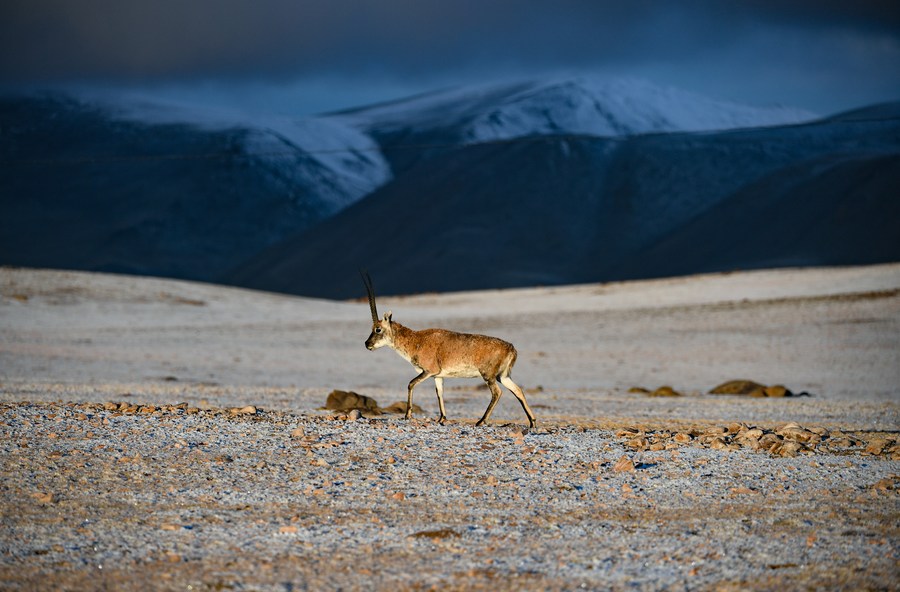China makes remarkable progress in biodiversity conservation through sustained efforts

A Tibetan antelope is pictured at the Qiangtang National Nature Reserve in southwest China's Tibet Autonomous Region, Sept. 25, 2021. (Xinhua/Jigme Dorje)
“Building a shared future for all life,” the theme of the International Day for Biological Diversity 2022 that fell on May 22, is a vivid portrayal of what China has been working on to better protect biodiversity over the past years.
China has continuously intensified its efforts to rescue rare and endangered wildlife and protect their habitats since 2012, achieving steady progress in maintaining the country’s rich biodiversity.
The populations of China’s rare and endangered wildlife have recovered in ever-greater numbers, and the country has brought 74 percent of key state-protected wildlife species under effective protection, according to the National Forestry and Grassland Administration.
Meanwhile, China has launched well-planned campaigns to save endangered species via measures such as in-situ and ex-situ conservation, artificial breeding, and reintroducing wildlife to natural habitats. Through many years of efforts, the country has effectively protected 90 percent of typical terrestrial ecosystem types and increased the populations of over 300 rare and endangered wild animals and plants.
In particular, the population of giant pandas has grown to 1,864, and the number of wild crested ibis has exceeded 6,000. Moreover, the population of wild Tibetan antelopes has rebounded to reach more than 300,000. The populations of elks and Przewalski’s horses, once nowhere to be found in the wild, have since grown to about 10,000 and 700 in size, respectively, through the use of artificial breeding, with many of them having been released back into the wild.
Besides, 206 species of rare and endangered wild plants have been reintroduced to their natural habitats, including 112 species native to China.
China has also launched the development of a protected areas (PA) system with a focus on national parks and a system of national botanical gardens, fostering a biodiversity conservation system that enhances in-situ and ex-situ conservation.
With a protected area of 230,000 square kilometers, China’s first batch of national parks is home to nearly 30 percent of the key terrestrial wildlife species found in the country. Meanwhile, China inaugurated the National Botanical Garden in Beijing, ushering in a new stage in the country’s endeavor to set up a national botanical garden system.
Moving forward, China will accelerate the development of the PA system to advance biodiversity conservation. By 2025, 75 percent and 80 percent of key terrestrial wild animal and plant species will be under effective protection, respectively.
China will identify about 50 national park candidate areas, which are expected to cover 10 percent of the country’s land area. These candidate national parks will contain the country’s most characteristic ecosystems and over 80 percent of the wild animals and plants under key national protection along with their habitats.
This year, China will set up a new batch of national parks in its key ecological regions, including the Qinghai-Tibet Plateau and the basins of the Yangtze River and the Yellow River.
The Biodiversity Committee under the Chinese Academy of Sciences (CAS) released the Catalogue of Life China: 2022 Annual Checklist, an updated national species database, on May 22. The latest checklist added 10,343 species compared with the 2021 checklist, bringing the total number of species to 138,293.
The species checklist provides a data framework that is beneficial for conducting better biodiversity research, while improving conservation and policy-making, according to an official with the biodiversity committee, adding that China is the only country that publishes a biological species checklist every year.
Photos
 China’s central bank to issue commemorative coins on cultural theme of auspiciousness, including two heart-shaped coins
China’s central bank to issue commemorative coins on cultural theme of auspiciousness, including two heart-shaped coins Population of endangered black-headed gulls exceeds 10,000 mark in NE China’s coastal city of Panjin
Population of endangered black-headed gulls exceeds 10,000 mark in NE China’s coastal city of Panjin China's self-developed floating airship breaks record
China's self-developed floating airship breaks record Chinese germplasm bank conserves biodiversity in warm temperate zone
Chinese germplasm bank conserves biodiversity in warm temperate zone
Related Stories
- Interview: Biodiversity-rich South Africa, China have a lot to share in this sector: conservationist
- More than 10 endangered plants discovered in east China
- Chinese germplasm bank conserves biodiversity in warm temperate zone
- Endangered Yangtze finless porpoises spotted in Yichang, Hubei Province
- Massive carbon emissions reduce biodiversity 300 mln years ago: study
- In pics: Exploring China's first National Botanical Garden in Beijing
- Measures will help protect most vulnerable wildlife
- Efforts pay off on saving endangered plant species
- From Russia to China, a thousands-mile journey of Siberian cranes
- Rare sea eagles spotted in China's Inner Mongolia
Copyright © 2022 People's Daily Online. All Rights Reserved.






